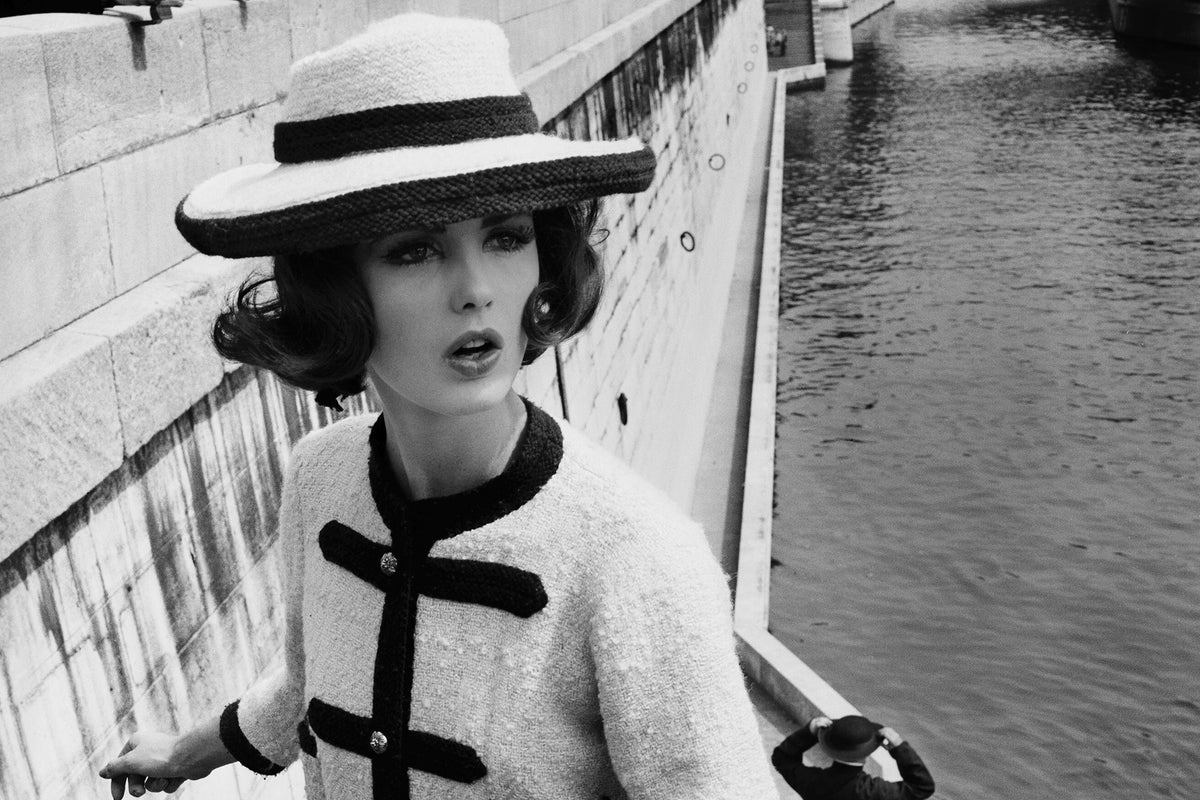
In 1953, Gabrielle “Coco” Chanel reopened her couture house after a 14-year hiatus at the age of 70. “Why did I return?” the legendary fashion designer later posited in an interview with Life magazine. “One night at dinner, Christian Dior said a woman could never be a great couturier.”
It’s a quote that perfectly captures everything Chanel represents to this day, more than a century after she opened her first millinery shop in Paris in 1910. It also happens to be nestled in the enormous boarded timeline of the designer’s life that greets visitors to Gabrielle Chanel: Fashion Manifesto, a major retrospective of the French couturière’s work, at the Victoria and Albert Museum in London.
Marking the first time that a UK exhibition has been dedicated entirely to Chanel, it charts the designer’s humble beginnings in the Loire Valley of France through to the establishment of her eponymous brand and the evolution of her creations throughout the years. Incorporating gowns, suits, jewellery, fragrances and accessories, the exhibition features more than 50 of the designer’s famous tweed suits alongside several fragile pieces usually stored deep within the belly of the V&A’s archive.
“We were very aware of the classic things people know about Coco Chanel,” says curator Connie Karol Burks, referencing the designer’s famous little black dresses, the 2.55 handbag and her tweed suits. “We really wanted to spotlight much more of what she contributed to fashion, and a bit more of her approach to designing clothes, like her need for comfort, simplicity and freedom of movement.”
It’s a modality easily expressed from the start of the exhibition, the entrance to which is a subtle, black, perfume-like box on the ground floor (the museum’s usual rotunda-like fashion space is currently occupied by its Diva exhibition). When downstairs, visitors may be surprised to find flowing frocks fitted with bows and pockets from as early as the 1930s. “She was an active independent woman, primarily designing for herself,” explains Karol Burks. “These were practical and elegant clothes.”
Practicality, as we soon learn, was an integral part of Chanel’s oeuvre. The exhibition celebrates the designer’s penchant for streamlined garments, clothes that rejected the stiff and restrictive aesthetics that had defined women’s wear just a few years earlier. It also includes details of her deep connection to Britain, including her friendships with figures from high society. While staying at the respective homes of Winston Churchill and the Duke of Westminster, Chanel embraced British sport, which is thought to be how the corresponding aesthetics of tweed and knitted jerseys found their way into her collections.
Also included here is a sketch of Chanel painted by Churchill while the two were staying at the Duke of Westminster’s Scottish retreat in 1928. “Coco is here,” he wrote to his wife at the time. “She fishes from morn till night, & in two months has killed 50 salmon.”
Three of Chanel’s outfits on display at the exhibition— ((c) Victoria and Albert Museum, London)
Elsewhere, highlights include the Chanel “Ford”, the name given to the designer’s little black dress that became a global staple for women everywhere. There are evening gowns aplenty, and an optic-white room entirely dedicated to the creation of the designer’s iconic perfume Chanel No 5, as well as an oval-shaped section devoted to Chanel’s tweed suits, with two rows of them spanning the curve of the room.
As has already been reported, the exhibition also doesn’t shy away from Chanel’s controversial wartime activities. It features previously unseen documents illustrating evidence of her collusion with Nazis during the Second World War, while also, confoundingly, unearthing evidence that indicates she was a member of the French resistance.
Gabrielle Chanel, Suit, wool tweed, braid, silk and metal. AutumnWinter 1964 © CHANEL Photo Nicholas Alan Cope.jpg— (V&A)
“It’s such a complex thing to get your head around,” says Karol Burks. “We felt it was important to have it in the exhibition and to display those original documents. But they almost give more questions than answers.”
Unlike the V&A’s Dior exhibition, which charted the brand’s existence beyond the life of its founder, the Chanel retrospective ends with the designer’s death in 1971. Given the label’s extensive history in modern culture, perhaps this makes sense: there’s only so much you can squeeze into one show. But in many ways, it is a limitation that produces a lingering sense of intrigue around the designer herself.
“Despite there being over 175 biographies [of Chanel], she’s still being written about and new information is still coming to light,” Karol Burks adds. “I don’t think anyone has quite pinned down who Gabrielle Chanel was. The more you learn about her, the less you know.”
‘Gabrielle Chanel: Fashion Manifesto’ runs from 16 September until 25 February at London’s Victoria & Albert Museum







